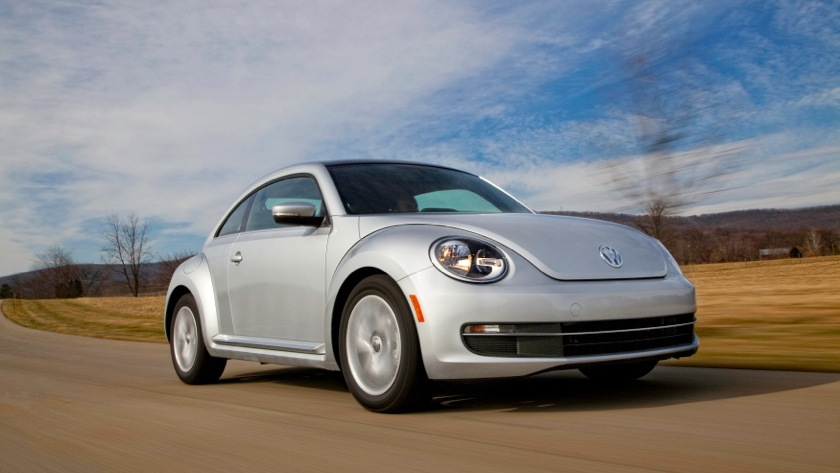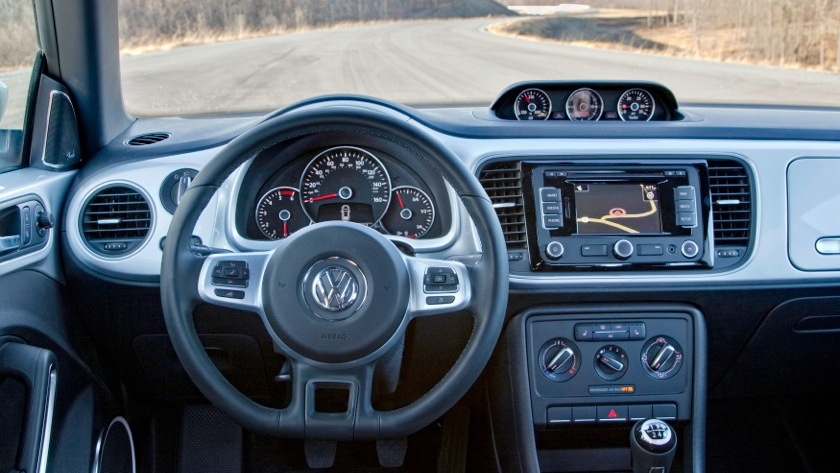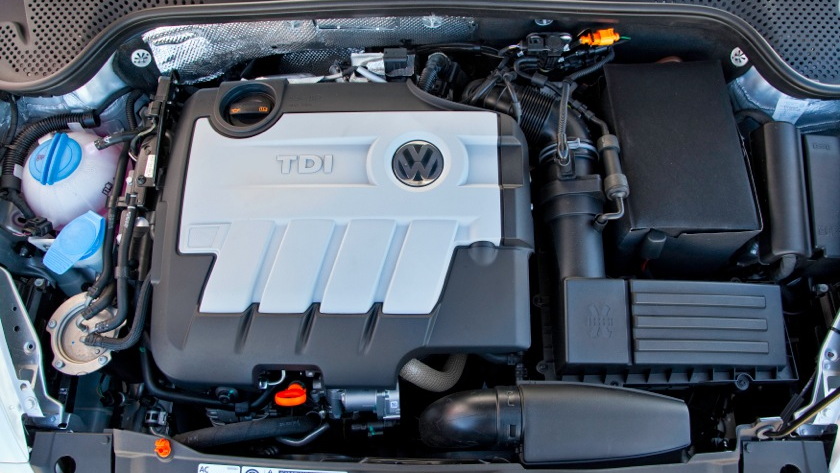Following the 2.5-liter and Turbo models, the Beetle TDI uses VW's familiar 140-horsepower, 236 pound-feet of torque 2.0-liter turbodiesel engine. Paired with a choice of six-speed manual or six-speed dual-clutch automatic transmissions, the Beetle TDI is also available in three core trim lines: TDI, TDI with Sunroof, and TDI with Sunroof, Sound, and Navigation.
The uninventive yet highly descriptive names give away the differences: while the base Beetle TDI comes with standard 17-inch alloy wheels, a chrome interior/exterior package, and a standard audio system, the Sunroof model adds a sunroof--but also upgrades the audio to a Premium VIII system with a touchscreen color display, six-disc changer, and an SD card reader. Upgrading to the top-tier model brings a Fender premium audio system, RNS 315 navigation system with five-inch touchscreen display, and a 400-watt Panasonic subwoofer.
Otherwise, the Beetle TDI is very closely matched to its gasoline-drinking counterparts. For the full release on the new diesel Beetle, read on to page two.
VOLKSWAGEN TO DEBUT THE FUEL-EFFICENT BEETLE TDI® AT THE
CHICAGO AUTO SHOW
The Beetle coupe range is rounded out by the thrifty TDI Clean Diesel model
- The most fuel-efficient 21st Century Beetle, with predicted fuel economy of
- 29 mpg city, 39 mpg highway
- Beetle TDI goes on sale this summer as a 2013 model
- The first Beetle TDI Clean Diesel model since 2006
- Available in three well-appointed trim levels
- Choice of six-speed manual or dual-clutch DSG® transmissions
Herndon, VA – The Volkswagen Beetle 2.5L and Turbo were launched to great acclaim from
both consumers and the media in 2011. At the Chicago Auto Show, VW will unveil the third
model in the Beetle lineup: the fuel-efficient TDI Clean Diesel model, which has manufacturer
fuel economy estimates of 39 mpg on the highway and 29 mpg in the city. The Beetle TDI, the
only Clean Diesel offering in the compact coupe category, will go on sale this summer as a
2013 model. Pricing will be announced closer to launch.
Engine and Transmission
The biggest difference between the TDI and other Beetle models lies, obviously, under the hood. The Beetle TDI uses the company’s 2.0-liter turbocharged, direct-injection Clean Diesel engine that makes 140 horsepower and 236 pound-feet of torque. Volkswagen pioneered the use of turbocharging and direct injection in diesel engines and continues to lead the industry in this technology.
This isn’t the first Beetle to be sold in the U.S. market with a diesel engine. From 1998 until 2006, the New Beetle was fitted with a 1.9-liter turbocharged four-cylinder diesel engine. Since then, this engine has been heavily revised to accommodate increasing demand for improvements in exhaust emissions and acoustics. One of the most fundamental improvements was converting the fuel-injection system to a common-rail design, as well as increasing the capacity by 72 cc thanks to a 1.5-mm wider bore.
The current engine features a cast-iron cylinder block and an aluminum-alloy cylinder head. It also utilizes some subtle design elements that contribute to longevity and the reduction of noise, vibration, and harshness. The forged steel crankshaft, for instance, uses just four counterweights, instead of eight, to reduce bearing load and noise emissions. The pistons incorporate annular channels into which oil is sprayed for cooling the piston-ring zone. A pair of counter-rotating balancer shafts is situated below the crankshaft in the oil pan.
Dual overhead camshafts are driven via a toothed belt that also powers the coolant pump and the high-pressure fuel-injection pump. The cams themselves are linked by means of spur gears that have an integrated backlash adjuster that helps to ensure quiet operation. Each cylinder has two intake and two exhaust valves.
The TDI engine’s intake manifold uses flap valves that are powered by a step motor that is in turn activated by the Engine Control Module (ECM). At idle and low engine speeds, the flap valves are closed in order to cause high swirl into the combustion chamber, which results in optimal mixture. During regular driving, the flap valves are adjusted continuously according to load and engine speed to ensure optimum air movement; above 3000 rpm, the valves open fully for maximum filling of the combustion chamber.
The engine’s turbocharger features adjustable guide vanes that maintain the best aspect ratio for low- and high-speed performance. In order to meet current tailpipe emissions standards in all 50 states, the engine makes use of both high- and low-pressure exhaust gas recirculation over all engine speeds, as well as an exhaust system that has a particulate filter and no fewer than three catalytic convertors: for oxidation, oxides of nitrogen (NOx), and hydrogen sulfide.
The engine is mated to either a six-speed manual transmission or VW’s innovative, dual-clutch DSG six-speed automatic. DSG combines the comfort and ease-of-use of an automatic, with the responsiveness and economy of a manual. The six-speed, transversely-mounted DSG unit features two wet clutches with hydraulic pressure regulation. One clutch controls the 'odd' gears—first, third, fifth and reverse—while the other operates the even gears. Essentially it is two gearboxes in one.
With DSG, the set-up allows the next-higher gear to be engaged but remain on standby until it is actually selected. In other words, if the Beetle is being driven in third gear, fourth is selected but not yet activated. As soon as the ideal shift point is reached, the clutch on the third-gear side opens, the other clutch closes and fourth gear engages under accurate electronic supervision.
Since the opening and closing actions of the two clutches overlap, a smooth gearshift results and the entire shift process is completed in less than four-hundredths of a second. In addition to its fully automatic shift mode, DSG has a Tiptronic® function to permit manual gear selection.
Design
The latest Beetle is more dramatic, with a stronger masculine design than the New Beetle that was sold between 1998 and 2010. The car breaks free of the design geometry defined by three semi-circles—front fender, rear fender, and domed roof above it. The roof profile actually runs distinctly lower and can be considered a development of the Ragster concept car shown in Detroit in 2005.
The 2012 Beetle is 71.2 inches wide (3.3 inches wider), 58.5 inches tall (0.5 inches lower) and 168.4 inches long (7.3 inches longer). The new focal point is the C-pillar. The development team also increased the car’s track widths and wheelbase. The changed proportions give the Beetle a powerful and dynamic appearance. The TDI differs externally from the 2.5 and Turbo in having unique 17-inch aluminum-alloy wheels, TDI badging, and a chrome trim line that caps the top of the door’s sheetmetal.
Inside, the car is distinctively styled, with colors and shapes that harken back to the original Beetle’s interior. Three round gauges are arranged in front of the driver (tachometer, speedometer, fuel gauge), providing key information at a glance. A multifunction display is integrated in the speedometer, which is housed in the central position in the binnacle. All TDIs gain a supplementary instrument pod that has oil temperature and turbo boost gauges and a stopwatch. Similar to the original Beetle, the car has an extra glovebox integrated into the dashboard—the kaeferfach or “Beetle bin”. The lid folds upward, while the standard glove box opens downward.
Even though the “cathedral ceiling” dome roof of the New Beetle has been replaced with a sleek and sporty roofline, front and rear passenger headroom remains plentiful. The longer roof section results in 0.4 inches more rear-seat headroom. Front legroom is improved, too, by 1.9 inches, and front shoulder room grows by 2.5 inches. Overall, the interior volume has increased from 81 to 85 cubic feet.
The trunk is significantly larger, offering 15.4 cubic feet of space, compared with the New Beetle’s 12.0 cubic feet; with the seats folded, the capacity increases to 29.9 cubic feet. A split-folding rear seat and a wide opening trunk lid ease loading and unloading.
Suspension
Beetle TDI models are fitted with a strut-type front suspension with a lower control arm and a 22-mm-diameter anti-roll bar. At the back, there’s a torsion beam arrangement that has coil springs and telescopic dampers. Like the Beetle Turbo, the TDI uses rack-and-pinion steering with electric power assistance.
All Beetle models have standard anti-lock brakes (ABS) with electronic brake pressure distribution (EBD). The Beetle TDI has 11.3-inch-diameter vented front discs and 10.7-inch-diameter rear disc brakes.
Safety and Security
The starting point in the Beetle’s safety armory is a very rigid body structure that uses ultra-high-strength, hot-formed steels in the crash-load paths and seamless laser welds. Electronic Stability Control (ESC) is standard, as are driver and front passenger airbags and Side Curtain Protection® airbags in front and rear. The Beetle includes Volkswagen’s advanced Intelligent Crash Response System that shuts off the fuel pump, unlocks the doors, and switches on the hazard lights if the car is involved in certain types of collision.
The Beetle TDI is also covered under the no-charge Carefree Maintenance Program®. All scheduled maintenance is covered for the length of the New Vehicle Limited Warranty—three years or 36,000 miles, whichever occurs first. Additionally, all current Volkswagen vehicles use synthetic oil, which, when combined with state-of-the-art German engineering, eliminates the need for a 5000-mile oil change, and allows owners to go farther between scheduled oil changes.
Model Lineup
There are three Beetle TDI Clean Diesel trim lines: TDI; TDI with Sunroof; and TDI with Sunroof, Sound, and Navigation. All three are very well equipped, with standard features such as power windows with one-touch up/down; cruise control; V-Tex Leatherette seating; the kaeferfach secondary glovebox; Bluetooth®; a leather-wrapped multifunction steering wheel with audio controls; three auxiliary gauges; Keyless entry with push-button start; and a Media Device Interface with iPod® cable.
TDI
The base TDI comes with standard 17-inch aluminum-alloy wheels, all the equipment listed above, and an interior and exterior chrome package. The standard RCD310 audio system has an AM/FM radio, CD player, Bluetooth®, and eight speakers.
TDI with Sunroof
This version takes the TDI’s standard equipment and adds a panoramic tilt/slide sunroof that is fully 80 percent larger than the one fitted to the New Beetle. The insulating glass blocks 99
percent of UV radiation and 92 percent of heat energy. The model’s Premium VIII audio system has a full-color touchscreen display, a six-disc CD changer, and an SD card reader.
TDI with Sunroof, Sound and Navigation
The topline TDI features the RNS 315 navigation system that has a five-inch touchscreen display. The Fender® Premium audio system that offers concert quality sound is also standard. This has an additional subwoofer, proprietary Panasonic® speaker technology that covers the cabin with directional sound, and 400 watts of output power.





